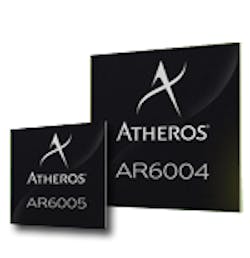Atheros AR6004
Atheros AR9462
While tablet computers, notebooks, and netbooks are getting more cellular connectivity each day, the embedded Wi-Fi radio still bears the real data load. With access points and hot spots everywhere, including at home, Wi-Fi remains the communication link of choice, simply because it is much faster and cheaper than a cellular network connection. But range and reliability are often an issue. Now, Atheros Communications is offering several Wi-Fi chips that significantly improve the performance of a wireless local area network (WLAN) connection for any mobile computer, e-reader, or smart phone.
The Atheros AR6004 is a dual-band (2.4 and 5 GHz), dual-stream (2x2 multiple-input, multiple-output or MIMO) 802.11n radio that can deliver up to 170-Mbit/s throughput with only a 15% increase in power consumption over the company’s flagship AR6003 single-stream chip. With the 2.4-GHz band increasingly crowded, the 5-GHz band offers less interference, more channels, and even 40-MHz bandwidths that boost data rates significantly. More and more mobile operators are relying on Wi-Fi to offload data and media traffic from the cellular network, making reliable Wi-Fi links a must for any mobile device.
Atheros is also launching its single-stream version of this chip, the AR6005. This tiny low-power chip targets lower-end feature phones and entry-level handsets. Its chip scale package has an area of only 12 mm2.
The AR6004 and AR6005 also feature the Wi-Fi DirectConnect peer-to-peer technology, which lets mobile devices talk to one another directly rather than through an access point (Fig. 1). In addition, these chips run the Atheros AP Mode, which turns a cell phone into a mobile hotspot by sharing its 3G Internet connection with other devices via a Wi-Fi link. Other features include serial data input/output (SDIO) and USB interfaces and support for Windows, Android, and other Linux-based operating systems (OSs). Single-antenna or dual-antenna configurations can be implemented as well.
Samples of the AR6004 should be available in the second quarter with full production in early 2012. Samples of the AR6005 will be available in the first quarter with volume shipments at the end of 2011.
Another Atheros chip, the AR9462, combines the dual-band 2x2 MIMO 802.11n radios with the latest Bluetooth version 4.0 low-energy capability (Fig. 2). This gives the chip a maximum data rate of 300 Mbits/s for offloading media and other data content from the cellular network. The peer-to-peer DirectConnect feature is also supported.
What sets the AR9462 apart is its Bluetooth capability. The latest Bluetooth 4.0 low-energy standard is implemented. Significantly improved Wi-Fi/Bluetooth co-existence features are implemented. The dual-antenna Wi-Fi transceivers can share one of the antennas with Bluetooth. Finally, the AR9462 works with ARM or x86 processors as well as Windows, Android, or other Linux OSs. A PCI Express interface is provided for the wireless local-area network (WLAN) connection, and a USB port is provided for Bluetooth.
Samples of the AR9462 are expected by early in second quarter this year. Single-band and dual-band reference designs are available.
About the Author

Lou Frenzel
Technical Contributing Editor
Lou Frenzel is a Contributing Technology Editor for Electronic Design Magazine where he writes articles and the blog Communique and other online material on the wireless, networking, and communications sectors. Lou interviews executives and engineers, attends conferences, and researches multiple areas. Lou has been writing in some capacity for ED since 2000.
Lou has 25+ years experience in the electronics industry as an engineer and manager. He has held VP level positions with Heathkit, McGraw Hill, and has 9 years of college teaching experience. Lou holds a bachelor’s degree from the University of Houston and a master’s degree from the University of Maryland. He is author of 28 books on computer and electronic subjects and lives in Bulverde, TX with his wife Joan. His website is www.loufrenzel.com.
